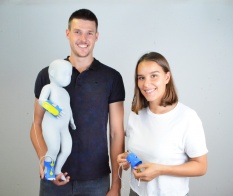What it does
AMBICA is a low cost medical device for monitoring dehydration in sick infants. It automatically keeps track of body water content over time. Its appropriate design reduces clinical workload and makes treatments more efficient in low resource settings.
Your inspiration
Dehydration is one of the main causes of infant death in developing countries. The lack of trained personnel, equipment, and facilities makes the timely assessment challenging and prevents patients from receiving the adequate treatment. In particularly vulnerable infants, care demands high attention from medical staff and is therefore costly and rarely achieved in low resource settings with high patient loads. Automating dehydration monitoring with a simple rehydration trend indicator that can be worn by the patient for the duration of the treatment could reduce the number of required check-ups, engage family members and optimize resources.
How it works
AMBICA is a wearable dehydration sensor that is based on bioimpedance analysis. Bioimpedance is the resistance that the human body opposes to a electrical current flowing through it. This resistance is directly related to the total body water content. We can determine if the patient is responding to treatment by measuring this resistance over time. To measure bioimpedance, four electrodes are attached to the body: two at the hand, and two at the foot. AMBICA consists of two ergonomically designed cuffs, which can fit both foot and hand, and contain the four electrodes that make contact with the skin. A main unit containing all electronics can be easily clipped on the cuff of the hand. With a single cable, the main unit is connected to the foot electrodes, therefore closing the circuit. With red and green LED indicator bars, the system displays an increasing or decreasing total body water content respectively; the length of the bars indicates the rate of change
Design process
We began our design process by evaluating the need for objective dehydration monitoring in low resource settings. The needs were largely defined by experiences from primary health care centres in South Africa. Various technologies were evaluated for their accuracy and suitability in low resource contexts. Bioimpedance analysis was the most promising method. We then defined the scenarios of how and where such a dehydration sensor can be used. With infants, their families, as well as clinical staff as our users, we continued to analyze working conditions, technical limitations and needs. The resulting design concept was defined by three main requirements: Integrity, affordability and communication. We started several iterations of collecting ideas and prototyping, followed by verification. This work resulted in two easy to manufacture and reusable cuffs, which are used to attach the electrodes to the patient’s body. The cuffs contribute to the integrity by protecting the electrodes from displacement and as a guide for separating the electrodes by the correct distance. Maximizing the number of reusable and sterilisable elements and the reduction from initially four cables to one reduced cost. Low-power LEDs communicate to clinical personnel about the infant’s dehydration trends.
How it is different
AMBICA has a small form factor and the ergonomic design addresses the needs of infants and overcomes the limitations of existing bulky bioimpedance systems which were designed for healthy adults in fitness applications. The idea to continuously monitor trend changes instead of absolute values is very innovative. It addresses the actual clinical need for objective measurements. Until now, clinicians relied on repeated, subjective observations. This was unreliable and time intensive. Our design takes local circumstances into account and empowers various stakeholders. It is not just another imported expensive medical device, but features simple manufacturing techniques that allow for local production, and therefore create a sustainable business. Further, its simple user interface promotes interaction with the infant’s family. Engaging caregivers and promoting health literacy has been shown to lead to better health outcomes (e.g. kangaroo neonatal care).
Future plans
We continue to make adjustments to the design of AMBICA to improve accuracy with the optimization of the electronics, and to reduce measurement noise and power consumption. For example, adding a low power accelerometer will detect movement and filter out artifacts. An experimental protocol is currently being drafted to perform prototype validation studies on children in South Africa. Usability, accuracy and effectiveness will be evaluated. We aim to create a not-for-profit organisation that supports local manufacture of such devices and distribution to clinics around the world.



Share this page on